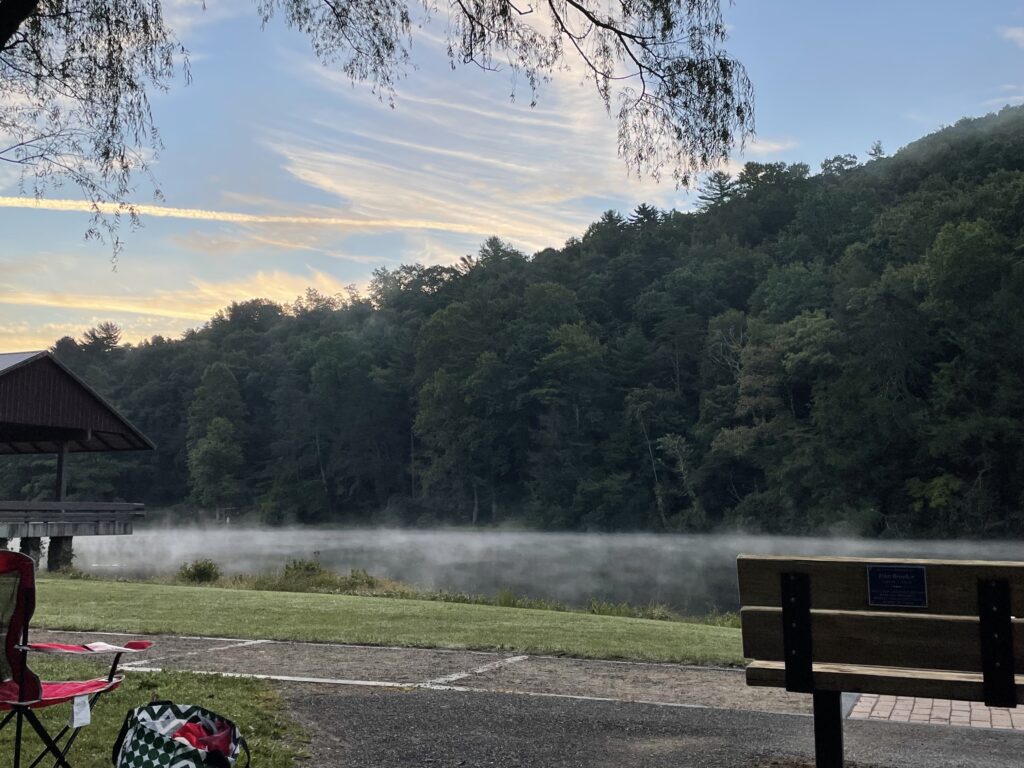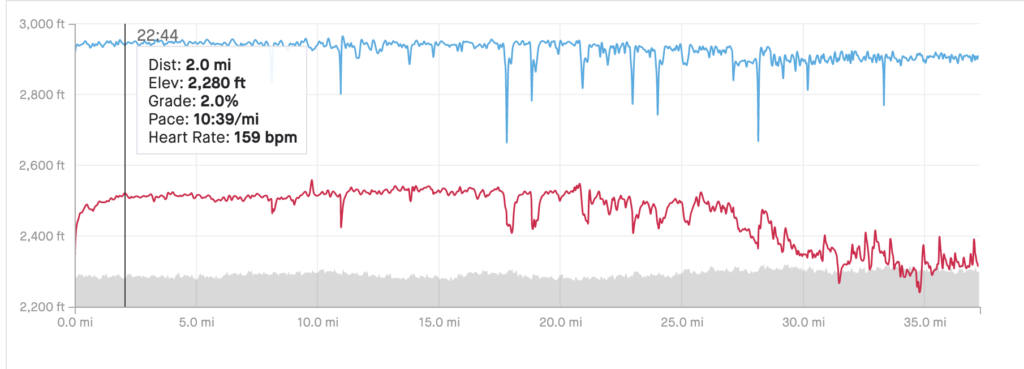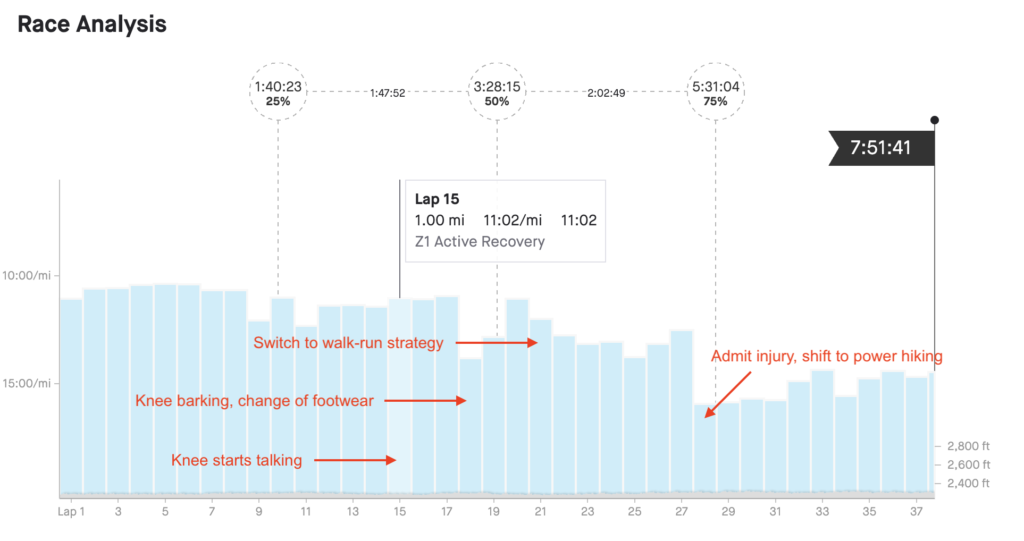I started the Lady of the Lake 8 hour race with high hopes. I came to race day with a ton of base mileage under my belt having completed multiple ultra-distance training runs over the summer. I was healthy, shooting for a 44 mile day, and hoping to challenge for a top three finish.
Things did not go my way. Just halfway into the race I knew my target of running 44 miles was not going to happen, and I ended the day far short of my goal, logging 37 miles by the time the clock ran out.
So what happened? That’s a good question, and there is an obvious answer: I hurt my knee. However, that’s not the whole story. Why did a knee that had held up for 40 and 50 mile training runs start barking just 15 miles into my day? Why was my heart rate up near 160 beats per minute (bpm) from the start while logging easy 10-11 minutes miles?
The answers to those questions are not quite as obvious, but it feels like finding those answers and learning the right lessons will play a deciding factor in the success of my ultra running endeavors in the near future.
The Lady of the Lake
Lady of the Lake is a race held annually at Vogel State Park in north Georgia. The race consists of a one-mile loop around Lake Trahlyta where each runner completes as many laps as possible around the course over the course of either four or eight hours.
Before I dive into a recap of how my day went off the rails I do want to say a few things about the race itself and share a few photos.
The race is organized by Revolution Running. This is the only one of their events that I’ve run, but it’s been very well organized the last two years and they really do a great job of putting on a race. If you’re considering any Revolution Running event, consider this my endorsement: I’d confidently register for any event put on by Revolution Running.
The course is beautiful. Vogel State Park is one of Georgia’s more popular, and thus better-maintained, state parks, and the trail around Lake Trahlyta is a beautiful rolling mix of single-track trail, smooth foot path, wooden bridges, grass, and just a little asphalt. It’s really a great place to spend a day and I’ve got the pictures to prove it.

Watching the sun come up, waiting on the race to get started. 
Crossing one of the wooden bridges. 
Some single-track goodness. 
Looking back across the lake nearing the end of the day. 
Still running! 
Walking it in. Wearing my feelings on my face.
Last year, I competed in the four-hour event and was pretty unprepared. My longest training run leading up to last year’s four-hour event was less than 10 miles and I really didn’t know what to expect once I pushed beyond that point. Somehow, I managed to run 21 miles in four hours – good enough for third overall, beating out the fourth place finisher by just seven seconds!
Leading up to this year’s race, my training was dramatically different. I logged individual training runs this past summer that surpassed my entire monthly mileage during the same months last summer. Let me provide some numbers to illustrate my point.
| Month and Year | Longest Run | Total Monthly Mileage |
| July 2020 | 6.8 miles | 29.6 miles |
| August 2020 | 6.6 miles | 46.7 miles |
| July 2021 | 33 miles | 150.8 miles |
| August 2021 | 50 miles | 180.1 miles |
In July 2021, my longest run was 33 miles long. That’s longer than all of the miles I ran in July 2020. Similarly, my longest run in August 2021 was 50 miles long, which is more than all the miles I ran in August 2020.
This is why I felt so confident coming into this year’s race. Last year, I managed 21 miles while relatively unprepared. This year, I felt extremely well-prepared and I was here to compete.
Nothing Went According to Plan
I started the race with a plan:
- Take it super easy for the first four hours, running at an effortless pace.
- Take stock after four hours and slow down a little if I was feeling fatigued.
- Finally, at the six hour point, take stock of my condition and push as hard as I felt I could for the last two hours.
If everything went according to plan I figured I’d log 22 miles in the first four hours just taking it easy, 10 more in the next 2 after slowing down a bit, and then somewhere between 8 and 12 in the final two hours depending on how I felt. If I felt great, that would mean I would end the day at 44 miles and if I was struggling, I’d wind up somewhere around the 40 mile mark.
That 40 mile target felt extremely realistic and doable. I covered 40 miles on August 1 and 50 miles on August 21, and both of those runs had a lot of elevation while the trail around Lake Trahlyta is relatively flat with just a little rise and fall. I wasn’t scared of the distance. Under perfect conditions, 44 miles felt possible; 40 miles almost felt like a layup.
Nothing went according to plan.
Heart Rate Troubles
The first sign that things weren’t going to go well is that my heart rate shot above 150 bpm within the first mile and stayed there. The idea during the first six hours was to run at a truly effortless pace. In my case, effortless generally means a heart rate around 140-145 bpm. My heart rate was 10-15 bpm higher than that, and showed no interest in coming down.

This is a problem I’ve had for the last couple of months. If I look at my Garmin data from back in the late Spring and early Summer, on really easy runs my heart rate was in the low-to-mid 140’s unless I was running uphill. More recently, while running at the same pace or even slower, my heart rate tends to push up into the mid-150’s.
I decided to ignore my slightly higher-than-ideal heart rate. I’ve logged a boatload of miles and I decided to just run by feel. My heart rate was higher than I wanted but I was breathing easy. Plus, what is race day for if not for pushing your limits?
Noisy Knee Syndrome Begins
Before I even got to the four hour mark, just 15 miles into my day, my right knee started talking.
Something I’ve learned as my runs have grown longer and longer is that sometimes a muscle or joint will talk to you for a few minutes and then quiet down. That’s not always the case, sometimes you’ve genuinely injured something and you need to stop, but if you stop every time you feel a twinge, you’ll never run long distances.
Part of being a distance runner is figuring out how to distinguish between a twinge that will go away and a genuine injury that’s just going to get worse if you keep going. It’s a skill I’m still a long way from mastering.
At 15 miles, my knee started talking. Not really hurting, just talking. “Fine, I’m listening, but if you stay at a 2/10 on the pain scale, I’m going to keep right on going.” By mile 18 the pain was at a 4/10, the talk had turned into a bark, and I stopped to try a change of footwear.
By mile 21, I realized the change of footwear hadn’t helped, the bark was getting worse and pushing above the 5/10 mark. The issue wasn’t going to go away so I shifted to a walk-run strategy: run for a few minutes until my knee was aching, then walk until the ache went away, wash, rinse, and repeat.
Finally, at mile 28 I gave in, stopped running, and started power hiking, resigned to the fact that I was injured.

Realistic Assessment of How Things Went
I was dramatically more prepared this year than last, yet didn’t run any faster than I did last year – I had completed 21 miles at the four-hour point this year, which is the same number of miles I ran in four hours last year – and I actually got hurt during the first four hours, which did not happen last year.
My heart rate was high right out of the gate, I hurt my knee, and I literally limped to the finish line. Things didn’t go well.
There is at least one silver lining I do take away from this year’s race. Last year, I was completely spent by the end of the four-hour race. Completely spent. Last year, absolutely everything between my feet and my hips ached constantly during the last 90 minutes of the race. I wasn’t injured, but I felt completely beat up: achy feet, sore muscles, sore joints.
Knee issues aside, I actually felt pretty great this year. My legs felt strong all day. 37 miles is no joke, regardless of pace, and aside from the knee I felt like I could keep right on going. Those 40 and 50 miles training runs definitely helped me build endurance.
What Went Wrong
I’m writing this race report about one week after the race. I haven’t gone on a run since the race, intent on letting my knee get healthy. I’ve spent a lot of time thinking about what happened last weekend and I’ve come to the conclusion that two factors contributed to my poor showing at this year’s race:
- I didn’t do very much long distance running where I ran continuously
- I was overtrained and didn’t give myself enough time to recover
My Long Runs Didn’t Include Enough Running
Yes, I had 40 and 50 mile training “runs” in August, but these efforts were completed on hilly trails and forest service roads. While I call these “runs”, the reality is that I walked just as far as I ran during these runs. The furthest distance I truly ran continuously during these training runs was probably just a mile or two. During these massive efforts, I walked every hill, and out in the woods where I log these efforts, there are a lot of hills.
If I think about my longest continuous runs, I’ve had very few continuous runs that have been more than 6 miles continuously. I can probably count on my fingers the number of efforts in all of 2021 where I’ve genuinely run more than 6 miles without stopping to walk up a long hill.
Contrast that with this year’s Lady of the Lake race where I ran 15 miles continuously before my knee started talking.
I don’t think the lack of long distance runs tells the whole story. After all, last year I covered 21 miles in four hours without hurting myself and similarly lacked really long continuous runs leading up to the race. But the lack of long runs where I ran the entire time is a part of the story.
Overtrained and Fatigued
I ran 150 miles in July. I ran 180 miles in August. I ran another 105 miles during the first 22 days of September.
I had a lot of 40+ mile weeks in August and September. In the six weeks prior to Lady of the Lake, I had 5 efforts that were longer than 20 miles.
That’s a lot of miles for a guy rapidly approaching 40 who was only running about 10 miles per week at the same time last year.
Prior to my knee injury, I had already spent about two weeks on the disabled list just about a month ago with an achy achilles tendon. And now the knee. My body is telling me that I’m pushing too hard. I’ve pushed my volume up too far too fast.
Where Do We Go From Here
Back when I first embarked on my running journey at the start of 2019 I told myself I’d be happy if I could just run a 5k without pain. In that first year, I only logged about 30 runs, but I managed to do what I set out to do: I could run a 5k and feel confident in my body’s ability to handle that level of exertion.
The lockdown of the summer of 2020 is when I started to ramp up my training. At the time, I was focused on the 10k distance and registered for the Lady of the Lake 4 hour race in a moment of inspiration. As underprepared as I was it was a risk, but I wanted to see if I could do it.
That race proved to be a gateway into the world of ultras. This past year I’ve run a trail marathon, two 50k ultras, the Lady of the Lake 8 Hour race, and logged a half dozen or so ultra-distance training runs. I’m certainly not a veteran ultra runner, but I’ve come a really really long way in a year.
However, my body is telling me I’ve pushed too far too fast. It’s time to back off a little to let my body adapt to the workload. At the same time, I do already have two more ultras on my calendar, and I certainly plan on toeing the line at each:
- Sky to Summit 50k on November 13, 2021.
- Conquer the Rock 50k on March 5, 2022 (followed by a 25k the next day)
So what’s the plan? Well, all plans are subject to adjustment as new information comes to light, but based on where I am today, here’s my plan.
- Let my knee recover fully. I haven’t run for a full week and I won’t be running at all for at least one more week. Right now, my plan is to go for a short test run next Sunday to gauge where I’m at.
- Ease back into running gradually. Hopefully this process will start next Sunday. However, if my knee gives me trouble next Sunday I’ll just keep taking time off of running until I’m confident my knee is ready. Once my knee is ready, I’ll not be jumping back into a 40 mile load right away. Right out of the gate, the load is likely to be more like 10 miles per week.
- Leave at least one full rest day between runs. Back when I first started ramping up my running in the summer of 2020, this was my one hard-and-fast rule: never run on back-to-back days. It wasn’t until the past summer that I started to routinely break that rule. For the time being, I’m going to reinstate that rule. I don’t know how long it will stick around, but at least through the end of the year.
- Focus on long runs. For the last few months, my running program has generally included four 5-6 miles runs during the week plus a 15-30 mile long run on the weekend. I’m going to shuffle things a bit. My runs during the week are going to get longer but less frequent while my weekend long run is going to get a little shorter. If all goes according to plan, in December I hope to be running about 10 miles twice during the week and logging another 10-15 miles out on the trails on the weekend.
We’ll see what happens once those pieces are in place. Perhaps I’ll add back one additional short run in January and focus on speed work during that shorter run (intervals, tempo pace, hill sprints, etc). That’s a bridge I’ll cross when I get there. The focus for now is on getting healthy, easing back into running gradually, giving myself plenty of time to recover between runs, and then making sure I’m getting in some longer continuous runs.
And what about those races? Well, I’m only six weeks away from Sky to Summit and I’m just not going to stress that race. I am well-prepared for it. I’ve logged a ton of miles and a ton of elevation over the summer. While I certainly do need to get some runs in between now and then, I’m not scared of the miles or the elevation. It’ll be a challenge, but even if I can’t get in any really long runs between now and then, I believe I can take it easy and finish the race well below cutoffs.
Conquer the Rock is another story entirely. It’s not for another 5+ months. So I’m just not going to worry about it for now. I’ll get past Sky to Summit in November, try to get my running program back on track in December, evaluate where I’m at in January, and build a plan from there.
